 |
Mesonotum without a transverse welt or torus |
-- |
Hypostomal teeth
(Non-type)
|
| -- |
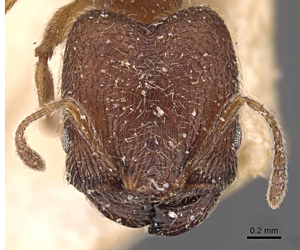
Head
straight sided in full face view; mandibles very stout edentate border
and without apical teeth; clypeus with median carina but anterior
margin no more than medially concave; with relatively slender
three-segmented club; postpetiole with distinct lateral prominences
produced as broad to acute spines
Minors with unusually small eyes, many distinctively ovoid
|
61 |
|
| -- |

Head
with sides mildly convex in full face view; mandibles very stout with
dentate border and distinct apical teeth; clypeus with at least a
shallow central notch and lateral carinae extending forward; with
relatively swollen three-segmented club; postpetiole hexagonal, with
distinct lateral prominences |
65 |
|
| . |
termitophila-group - bequaerti, minuscula,
nigritella, schoutedeni, strator
& termitophila |
-- |
|
| -- |

TL 2.5 mm, HL 1.15, HW 1.09,
SL 0.59, PW 0.50; CI 96, SI 54; brown, gaster darker; head
with
strange lateral profile; dense decumbent short pilosity |
. |
|
| . |
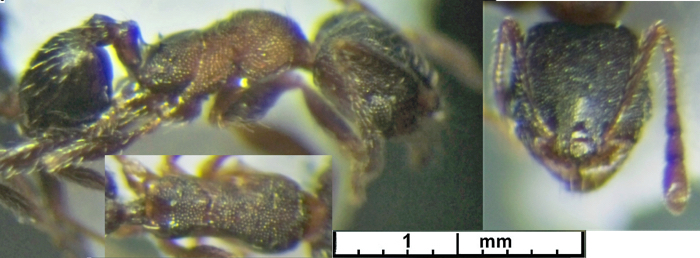
TL 2.05 mm, HL 1.00, HW 0.93,
SL 0.85, PW 0.32; CI 94, SI 03; mandibles striate, puncturate at the
extremities; head square,
occiput lightly impressed, scape just surpassing the occiput, eyes
large, clearly elongate, longer than their distance from the anterior
of the head, set in the anterior third, funiculi with middle segments
wider than long; promesonotum strongly convex; propodeum with
horizontal dorsum, almost as wide as long, with the spines short about
one third of the basal separation, subvertical; postpetiole not much
wider than the petiole; head, alitrunk and pedicel entirely matt and
densely reticulo-punctate, head with fairly strong lateral rugae;
gaster anteriorly reticulate and subopaque, smooth posteriorly as are
the legs; head dark brown, rest lighter brown, appendages and mandibles
reddish brown
Note the thumbnail is of a specimen from Senegal that has a lighter
head but shows the peculiar elongated eye and dense sculpturation |
Zaïre -
bequaerti |
|
| -- |
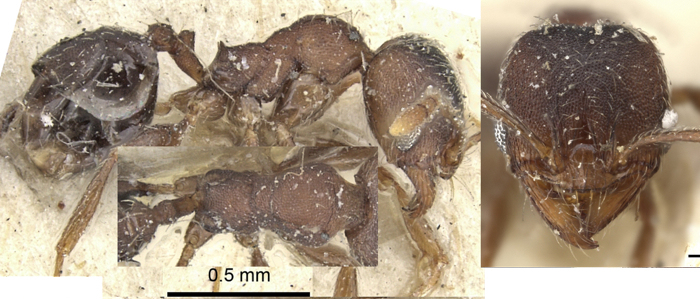
Minor only, TL ca 1.83, HL0.49, HW 0.49, SL 0.45, PW
0.60; CI 100, SI 94;
distinctive elongated oblique eye, similar to that of bequaerti) - may well be the senior
synonym of bequaerti
Note: the described major was not associated with the minors and was
far too big
|
Tanzania - katonae |
|
| -- |

TL 3.6-3.8 mm, HL 1.22, HW 1.04,
SL 0.58, PW 0.48; CI 85, SI 52; black; head with
strange lateral profile; sparse, long fine pilosity
|
. |
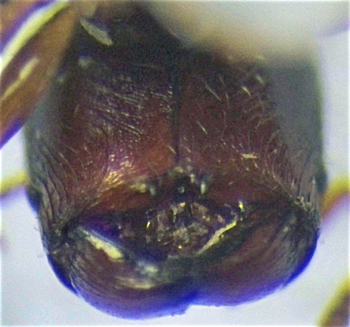
|
| . |
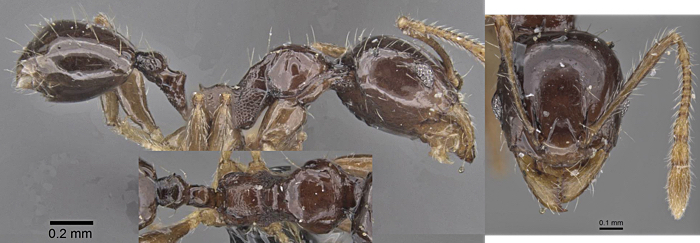
TL
2.0-2.1, HL 0.59, HW 0.54, SL 0.54, PW 0.30; CI 92, SI 100; black, very
shiny, puncturation fine and
serrated, appendages brown. Head slightly longer than wide, very
rounded posteriorly; occiput is straight, bordered and wide. Antennae
slender, in the funiculus segments 2 and 3 are equal, three times
longer than wide, segment 4 twice as long as wide. Prothorax as convex
as the soldier; propodeum puncturate except on anterior third. Petiole
slender, node less elevated than that of the soldier. Postpetiole as
the soldier. All body parts are more elongated than those of the other
minute Pheidole in the termitophila group
|
Guinea
to Congo Basin
- nigritella |
|
.
|
|
|
|
| -- |

TL 2.2 mm; HL 20% >
HW; frontal carinae very divergent and only one-quarter of length of
scape, no scrobes, scape surpasses mid-point of face; post-petiole
unusually small in width and height; head with fine
and somewhat spaced longitudinal striations which reach occipital
border, rest of body mostly smooth; mostly pale yellow, anterior of
clypeus and mandibles darker (junior synonym minuscula)
|
. |
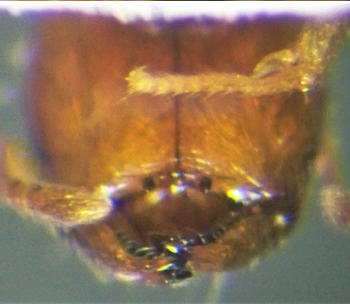
|
| . |

TL 1.7; body yellow-brown, very shiny, petiole
and appendages testaceous.; head a little longer than wide, with fine
puncturations; occiput concave, wide and not bordered; propodeal spines
reduced to
short teeth. postpetiole globular
|
Guinea
and Cameroun
- tricarinata |
|
.
|
| -- |
major TL > 3.0 mm |
64 |
|
| -- |
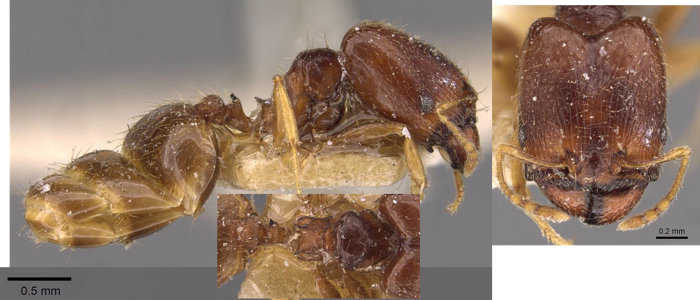
TL
3.4-3.5 mm, HL 1.08, HW 0.92, SL 0.42, PW 0.44; CI 85, SI 45; generally
pale yellow-brown |
. |
|
| . |
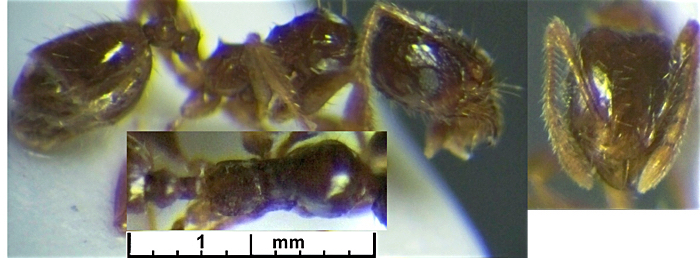
TL
ca 2.2, HL 0.50 HW 0.48, SL 0.45, PW 0.52; CI 85 SI 100; head with
weakly concave occiput; mandibles smooth
with distinct puncturation, each puncture giving rise to a fine
decumbent hair; eyes ovoid set around the midlength of the head;
Alitrunk profile with promoseontum highly domed and dropping steeply
into the shallow metanotal groove, propodeum profile very shallowly
convex, spines reduced to sharp denticles; femora unique in being
distinctly swollen; propodeum dorsum with coarse spiculation; short
erect hairs moderately abundant all over.
Colour varies from dark chestnut to near black
|
Sahel
zone - termitophila |
|
| -- |
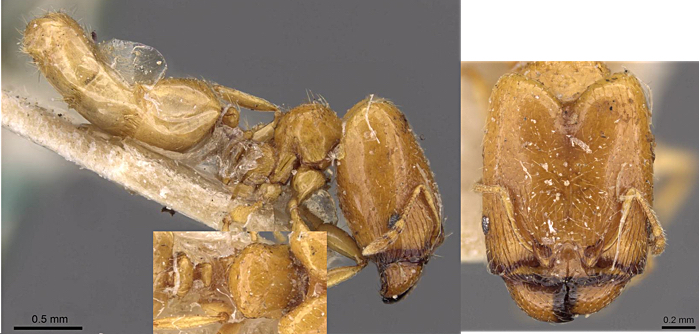
TL
3.8-4.0 mm HL 1.24, HW 1.00, SL 0.40, PW 0.55; CI 80, SI 41; vertex
only longitudinally striate; head
reddish-brown, alitrunk and gaster very dark-brown (ssp fugax,
type lighter?) |
. |
|
| . |
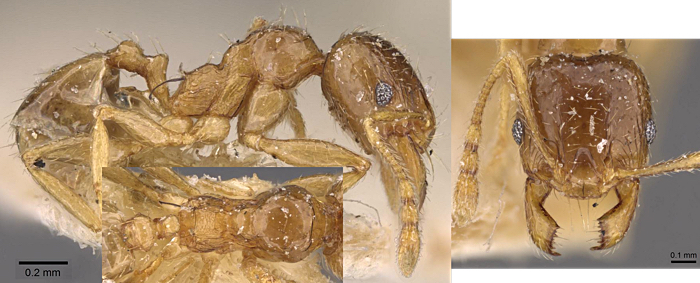
Minor TL ca 2.0 mm, HL
0.58, HW 0.50, SL 0.50, PW 0.26; CI
94, SI 100; yellow brown, appendages darker |
Eastern
Africa - strator |
|
 |
Head with at least moderately arcuate sides |
-- |
|
| -- |
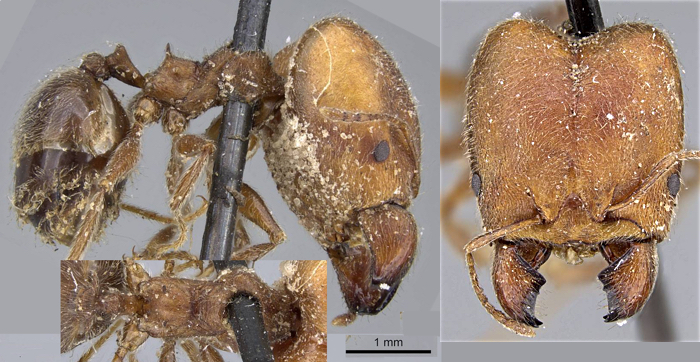
TL
ca 8 mm, HL 2.72, HW 2.55, SL 1.03, PW 1.15; CI 94, SI 40; propodeal
spines of major relatively long, stout and upturned;
petiole with a markedly emarginate narrow dorsal face; postpetiole
strongly produced laterally to form a blunt triangular process. Colour
red-brown, dull due to dense puncturation and abundant covering of
moderately long, semi-prone, fine hairs.
|
. |
|
| . |

fulvobasalis |
Pan-African
- excellens.
|
|
| -- |

TL 7.2 mm, HL 2.76, HW 2.60, SL 1.00, PW 1.22; CI 94, SI
38; mostly
brown-black, head reddish with a frontal yellowish-red band, tibiae and
scapes brown-yellow, tarsi & funiculi yellowish gaster segments
with posterior border yellowish |
. |
|
| -- |

TL
3.0 mm, HL 0.80, HW 0.72, SL 0.83, PW 0.50; CI 90, SI 112; scape
longer; mostly dark red-brown, head
reddish with a frontal yellowish-red band, tibiae and scapes
brown-yellow, tarsi & funiculi yellowish |
Congo
Basin, Ghana & Nigeria - weissi |
|
| -- |
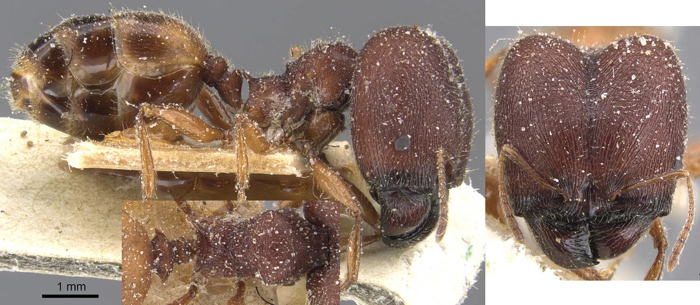
TL
ca 8 mm, HL 2.72, HW 2.55, SL 1.03, PW 1.15; CI 94, SI 40; propodeal
spines of major relatively long, stout and upturned;
petiole with a markedly emarginate narrow dorsal face; postpetiole
strongly produced laterally to form a blunt triangular process. Colour
red-brown, dull due to dense puncturation and abundant covering of
moderately long, semi-prone, fine hairs.
|
. |
|
| . |
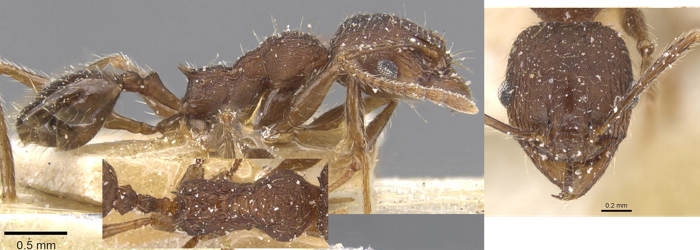
TL
|
Pan-African
- fulvobasalis
|
|
|
|
|
|
| -- |
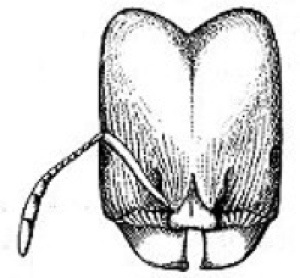
TL
6.2 mm, HL 2.3, HW 2.0 ; CI 0.80, SI 56; head relatively shiny
especially on occiput; with sparse
whitish fine erect hairs; postpetiole broader than long, its sides
produced as short, acute, backwardly directed spines, the distance
between the tips of which is about three times the width of the petiole |
. |
|
| . |
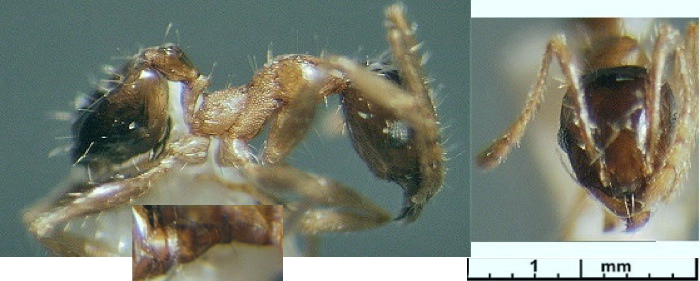
TL
ca 2.3 mm, HL 0.64, HW 0.57, SL 0.68, PW 0.39; CI 92, SI 109; head a
little longer than broad, as broad in front
as behind, with feebly convex sides and a feebly concave posterior
border; eyes rather convex, just in front of the middle of the sides;
mandibles with the whole apical border very finely denticulate; clypeus
convex, its anterior border entire, broadly rounded; scapes extending
fully one-fourth their length beyond the posterior border of the head;
alitrunk and petiole very similar to those of the soldier but the
mesonotum more sloping and with much feebler transverse convexity;
postpetiole only one and one-half times as broad as the petiole, its
sides produced as short angles or conules; shining; mandibles finely
and indistinctly striate; clypeus and cheeks longitudinally rugulose;
area between the frontal carinae and the eyes reticulate, remainder of
head very smooth and shining; pronotum smooth and shining above,
reticulate on the sides; mesonotum and propodeum subopaque, densely
punctate; petiole and post-petiole more finely punctate, the nodes
above smooth and shining like the gaster and legs; pilosity and colour
much as in the major, but the fine appressed hairs on the scapes as
abundant as on the legs; rich castaneous brown; gaster, except the base
of the first segment, darker, almost black; legs and funiculi a little
more reddish, the femora infuscated in the middle. |
Zaïre -
mylognatha
|
|
| -- |

TL 4.5
mm, HL 1.13, HW 0.95, SL 0.42, PW 0.5; CI 84, SI 44; quite distinctive,
especially the elongated head with a bulging
occiput when viewed in profile; head brown, body darker posteriorly to
a near black gaster, tarsi yellow; erect hairs long, fine and abundant. |
. |
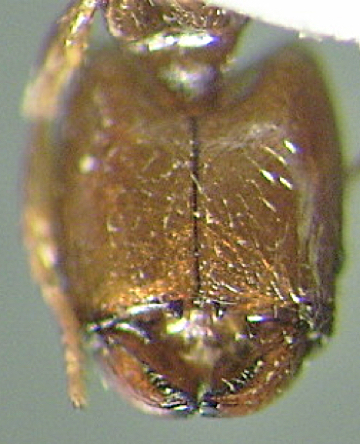 |
| . |

TL
2.0 mm, HL 0.59, HW 0.47, SL 0.62, PW 0.31; CI 85, SI 121; scape just
surpasses the occiput; propodeal
spines short, near-vertical; postpetiole node about twice as wide as
petiole, slightly longer than wide; dull yellow, with the legs and
antennae lighter and the mid-gaster brownish. |
Zaïre
& Nigeria - schoutedeni |
|
| -- |

TL 5.7 mm,
HL 2.41, HW 2.12, SL 1.30, PW 0.76; CI
88, SI 64; head about a
quarter longer than wide but with convex sides; scapes narrow but reach
posterior third of the head; propodeal spines strong, blunt, about as
long as half the propodeum dorsum and erect; and occipital lobes very
smooth and shiny but rest of head densely reticulate and matt;
black-brown; anterior of head and appendages lighter red-brown to
yellow-brown |
. |
|
| . |
 TL
3.0-3.5 mm, HL 0.88, HW 0.74, SL 1.00, PW 0.43; CI 90, SI 133; head
oval; eyes set at the mid-point and occiput
narrower, with a weak transverse crest (?nuchal collar); scape
surpasses occiput by about one-third its length; generally shiny with a
few rugae on the genea and the mesonotum and propodeum partly
reticulate; colour black, anterior of head and appendages lighter
red-brown to yellow-brown TL
3.0-3.5 mm, HL 0.88, HW 0.74, SL 1.00, PW 0.43; CI 90, SI 133; head
oval; eyes set at the mid-point and occiput
narrower, with a weak transverse crest (?nuchal collar); scape
surpasses occiput by about one-third its length; generally shiny with a
few rugae on the genea and the mesonotum and propodeum partly
reticulate; colour black, anterior of head and appendages lighter
red-brown to yellow-brown |
Cameroun
& Congo Basin - retronitens |
|
|
 Top of page Top of page
|
|
|
|